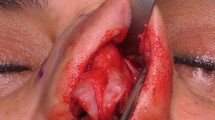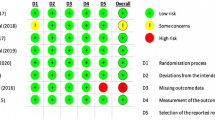Abstract
To compare conventional osteotomy with the piezosurgery medical device, in terms of postoperative edema, ecchymosis, pain, operation time, and mucosal integrity, in rhinoplasty patients. In this prospective study, 49 rhinoplasty patients were randomly divided into two groups according to osteotomy technique used, either conventional osteotomy or piezosurgery. For all patients, the total duration of the operation was recorded, and photographs were taken and scored for ecchymosis and edema on postoperative days 2, 4, and 7. In addition, pain level was evaluated on postoperative day 2, and mucosal integrity was assessed on day 4. All scoring and evaluation was conducted by a physician who was blinded to the osteotomy procedure. In the piezosurgery group, edema scores on postoperative day 2 and ecchymosis scores on postoperative days 2, 4, and 7 were significantly lower than in the conventional osteotomy group (p < 0.05). On postoperative day 2, the pain level was lower in the piezosurgery group than in the conventional osteotomy group (p < 0.05). In an endoscopic examination on postoperative day 4, while 24% of the patients in the conventional osteotomy group had mucosal damage, no such damage was observed in the piezosurgery group. When total operation duration was compared, there was no significant difference between the groups (p > 0.05). Piezosurgery is a safe osteotomy method, with less edema (in the early postoperative period) and ecchymosis compared with conventional osteotomy, as well as less pain, a similar operation duration, and no mucosal damage.






Similar content being viewed by others

References
Kienstra MA, Sherris DA, Kern EB (1999) Ostetomy and pyramid modification in the Joseph and Cottle rhinoplasty. Facial Plast Surg Clin North Am 7:279–294
Halewyck S, Michel O, Daele J, Gordts F (2010) A review of nasal dorsal hump reduction techniques, with a particular emphasis on a comparison of component and composite removal. B-ENT 6(Suppl 15):41–48
Giacomarra V, Russolo M, Arnez ZM et al (2001) External osteotomy in rhinoplasty. Laryngoscope 111:433–438
Guyuron B (1998) Nasal osteotomy and airway changes. Plast Reconstr Surg 102:856–860
Murakami CS, Larrabee WF Jr (1992) Comparison of osteotomy techniques in the treatment of nasal fracture. Facial Plast Surg 8:209–219
Gryskiewicz JM, Gryskiewicz KM (2004) Nasal osteotomies: a clinical comparison of the perforating methods versus the continuous technique. Plast Reconstr Surg 113:1445–1456
Trenite GJ (1991) Trauma reduction in rhinoplastic surgery. Rhinology 29:111–116
Goldfarb M, Gallups LM, Gerwin JM (1993) Perforating osteotomies in rhinoplasty. Arch Otolaryngol Head Neck Surg 119:624–627
Robiony M, Toro C, Costa F et al (2007) Piezosurgery: a new method for osteotomies in rhinoplasty. J Craniofac Surg 18:1098–1100
Olivier Gerbault MD, Rollin K, Daniel MD (2016) The role of piezoelectric instrumentation in rhinoplasty surgery. Aesthet Surg J 36(1):21–34
Robiony M, Polini F, Costa F et al (2007) Ultrasound piezoelectric vibrations to perform osteotomies in rhinoplasty. J Oral Maxillofac Surg 65:1035–1038
Cochran CS, Roostaeian J (2013) Use of the ultrasonic bone aspiratör for lateral osteotomies in rhinoplasty. Plast Recon Surg 132(6):1430–1433
Tirelli G, Tofanelli M, Bullo F, Bianchi M, Robiony M (2015) External osteotomy in rhinoplasty: piezosurgery vs osteotome. Am J Otolaryngol 36(5):666–671
Ilhan AE, Cengiz B, Eser BC (2016) Double-blind comparison of ultrasonic and conventional osteotomy in terms of early postoperative edema and ecchymosis. Aesthet Surg J 36(4):390–401
Taşkın T, Batmaz T, Erdil M, Aydın S, Yücebaş K (2016) The comparison of edema and ecchymosis after piezoelectric and conventional osteotomy in rhinoplasty. Eur Arch Otorhinolaryngol 274(2):861–865. doi:10.1007/s00405-016-4306-9
Kara CO, Gokalan I (1999) Effects of single dose steroid usage on edema, ecchymosis and intraoperative bleeding in rhinoplasty. plastic reconstructive. Surgery 104:2213–2218
Xu F, Zeng W, Mao X et al (2008) The efficacy of melilotus extract in the management of postoperative ecchymosis and edema after simultaneous rhinoplasty and blepharoplasty. Aesth Plast Surg 32:599–603
Gurlek A, Fariz A, Aydogan H, Ersöz-Oztürk A, Evans GR (2009) Effects of high dose corticosteroids in open rhinoplasty. J Plast Reconstr Aesthetic Surg 62(5):650–655
Totonchi A, Guyuron B (2007) A randomized, controlled comparison between arnica and steroids in the management of postrhinoplasty ecchymosis and oedema. Plast Reconstr Surg 120(1):271–274
Saedi B, Sadeghi M, Fekri K (2011) Comparison of the effect of corticostreroid therapy and decongestant on reducing rhinoplasty edema. Am J Rhinol Allergy 25:141–144
Kara CO, Kara IG et al (2005) Does creating a subperiosteal tunnel influence the periorbital edema and ecchymosis in rhinoplasty? J Oral Maxillofac Surg 63:1088–1090
Becker DG, McLaughlin RB, Loevner LA et al (2000) The lateral osteotomy in rhinoplasty: clinical and radiographic rationale for osteotome selection. Plast Reconstr Surg 105:1806–1816
Rohrich RJ, Krueger JK, Adams WP et al (2001) Achieving consistancy in the lateral nasal osteotomy during rhinoplasty: an external perforated technique. Plast Reconstr Surg 108:2122–2132
Caner Kilic MD, Umit Tuncel MD (2015) Effect of the rhinoplasty technique and lateral osteotomy on periorbital edema and ecchymosis. J Craniofac Surg 26(5):e430–e433
Mottura AA (2011) Internal lateral nasal osteotomy: double guarded osteotome and mucosa tearing. Aesthetic Plast Surg 35:171–176
Rohrich RJ, Minoli JJ, Adams WP et al. The lateral nasal osteotomy in rhinoplasty. An anatomic endoscopic comparison of the external versus the internal approach. Plast Reconstr Surg 1997:1309
Landes CA, Stübinger S, Ballon A, Sader R (2008) Piezoosteotomy in orthognathic surgery versus conventional saw and chisel osteotomy. Oral Maxillofac Surg 12(3):139–147
Robiony M, Polini F, Costa F et al (2004) Piezoelectric bone-cutting in multipiece maxillary osteotomies. J Oral Maxillofac Surg 62(6):759–761
Crippa B, Salzano FA, Mora R, Dellepiane M, Salami A, Guastini L (2011 Sep) Comparison of postoperative pain: piezoelectric device versus microdrill. Eur Arch Otorhinolaryngol 268(9):1279–1282
Salami A, Mora R, Crippa B, Dellepiane M, Guastini L (2010) Piezoelectric stapedotomy: the importance of a micropulse program. Acta Otolaryngol 130(12):1364–1369
Salami A, Dellepiane M, Mora R (2008) A novel approach to facial nerve decompression: use of piezosurgery. Acta Otolaryngol 128(5):530–533
Salami A, Dellepiane M, Salzano FA, Mora R (2009) Piezosurgery in endoscopic dacryocystorhinostomy. Otolaryngol Head Neck Surg 140(2):264–266
Salami A, Dellepiane M, Crippa B, Mora R (2010) A new method for osteotomies in oncologic nasal surgery: piezosurgery. Am J Otolaryngol Head Neck Med Surg 31:150–153
Gellner V, Koele W, Wolf A, Gerstenberger C, Mokry M, Stammberger H, Tomazic PV (2016) A piezoelectric device for bone work in endoscopic anterior skull base surgery—a feasibility study in 15 patients. Clin Otolaryngol. doi:10.1111/coa.12760
Pribitkin EA, Lavasani LS, Shindle C, Greywoode JD (2010) Sonic rhinoplasty: sculpting the nasal dorsum with the ultrasonic bone aspirator. Laryngoscope 120(8):1504–1507
Vercellotti T, Crovace A, Palermo A et al (2001) The Piezoelectric osteotomy in orthopedics;clinical and histological evaluations (pilot study in animals). Mediterr J Surg Med 9:89–96
Ghassemi A, Prescher A, Talebzadeh M, Hölzle F, Modabber A (2013) Osteotomy of the nasal wall using a newly designed piezo scalpel–a cadaver study. J Oral Maxillofac Surg 71(12):2155.e1-6
Harshbarger RJ, Sullivan PK (1999) Lateral nasal osteotomies: implications of bony thickness on fracture patterns. Ann Plast Surg 42:365–370
Yosry M, Othman IS (2008) Controlled hypotension in adults undergoing choroidal melanoma resection: comparison between the efficacy of nitroprusside and magnesium sulphate. Eur J Anaesthesiol 25(11):891–896
Tuncel U, Turan A, Bayraktar MA (2013) Efficacy of dexamethasone with controlled hypotension on intraoperative bleeding, postoperative oedema and ecchymosis in rhinoplasty. J Cranio Maxillo Facial Surg 41(2):124–128
Szychta P, Antoszewski B (2010) Assessment of early postoperative pain following septorhinoplasty. J Laryngol Otol 124:1194–1199
Sari E, Simsek G (2015) Comparison of the effects of total nasal block and central facial block on acute postoperative pain, edema, and ecchymosis after septorhinoplasty. Aesth Plast Surg 39:877–880
Demirhan A, Tekelioglu UY (2013) Effect of pregabalin and dexamethasone addition to multimodal analgesia on postoperative analgesia following rhinoplasty surgery. Aesth Plast Surg 37:1100–1106
Author information
Authors and Affiliations
Corresponding author
Ethics declarations
Ethical approval
This study was approved by the Local Ethics Committee (Bezmialem Foundation University, Decision No. 01/21) for clinical studies. The patients were informed about the surgical procedures and the possible complications and informed consent was obtained from all individual participants included in the study.
Conflict of interest
The authors have no conflicts of interest and/or financial interest to disclose. No financial support was received for this work.
Rights and permissions
About this article
Cite this article
Koçak, İ., Doğan, R. & Gökler, O. A comparison of piezosurgery with conventional techniques for internal osteotomy. Eur Arch Otorhinolaryngol 274, 2483–2491 (2017). https://doi.org/10.1007/s00405-017-4514-y
Received:
Accepted:
Published:
Issue Date:
DOI: https://doi.org/10.1007/s00405-017-4514-y



